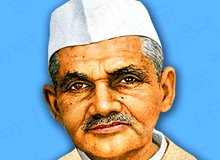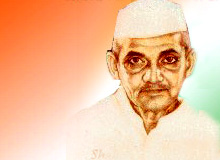 Born: 2 October 1904
Born: 2 October 1904Passed Away: 11 January 1966
Contributions
He devoted his life for the pride and honor of the country. Shastri was regarded as man of principles. Lal Bahadur Shastri offered his resignation as Union Railway Minister; hours after he was made aware of a train accident that killed around 150 people. He laid the foundation stones of the well-productive schemes like Green Revolutions and White Revolutions. He was the first person to be posthumously awarded the "Bharat Ratna".
Life
Lal Bahadur Shastri was born on October 2, 1904, to Ramdulari Devi and Sharada Prasad Shrivastava, in Moghalsarai, United Province (Uttar Pradesh). He shares his birthday with Mahatma Gandhi, the father of the nation. Lal Bahadur was against the prevailing caste system and therefore decided to drop his surname. The title "Shastri" was given after the completion of his graduation at Kashi Vidyapeeth, Varanasi in 1925. The title "Shastri" refers to a "scholar" or a person, adept in the "Holy Scriptures".
His father Sharada Prasad, a schoolteacher by profession, passed away when Lal Bahadur was barely two years old. His mother Ramdulari Devi took him and his two sisters to their maternal grandfather Hazari Lal's house. Lal Bahadur acquired virtues like boldness, love of adventure, patience, self-control, courtesy, and selflessness in his childhood. After completing his primary education at Mirzapur, Lal Bahadur was sent to Varanasi, where he stayed with his maternal uncle.
Young Lal Bahadur, inspired with the stories and speeches of national leaders, developed a desire to participate in the Indian nationalist movement. He would also spend time by reading foreign authors like Marx, Russell and Lenin. In 1915, a speech of Mahatma Gandhi changed the course of his life and decided to jump into the fire of Indian freedom struggle.
In order to participate actively in the freedom movement, Lal Bahadur neglected his studies. In 1921, during the non-cooperation movement, called by Mahatma Gandhi, Lal Bahadur was arrested for demonstrating in defiance of the prohibitory order. Sine he was a minor then, the authority had to release him. In 1928, Lal Bahadur Shastri married Lalita Devi, the youngest daughter of Ganesh Prasad. He was against the prevailing "dowry system" and so refused to accept dowry. However, on the repeated urging of his father-in-law, he agreed to accept only five yards of khadi (cotton, usually handspun) cloth as dowry.
Active Nationalist
In 1930, Lal Bahadur Shastri became the secretary of the Congress party and later the president of the Allahabad Congress Committee. He played a crucial role during the "Salt Movement". Lal Bahadur lead a door-to-door campaign, urging people not to pay land revenue and taxes to the British authority. The leader was also sent to jail for the campaign. During the long span of nine years he spent in jails, Lal Bahadur utilized the time in reading the social reformers and western philosophers. He was one of the leading and prominent faces that continued the Quit India movement, called by Mahatma Gandhi. Lal Bahadur, in 1937, was elected to the UP Legislative Assembly.
Post Independence
 Lal Bahadur Shastri had served in various positions before being elected as the Prime Minister. After Independence, he became the Minister of police in the Ministry of Govind Vallabh Panth in Uttar Pradesh. His recommendations included the introduction of "water-jets" instead of sticks to disperse the unruly mob. Impressed with his efforts in reforming the state police department, Jawaharlal Nehru, invited Shastri to join the Union cabinet as a Minister for railways. He was a responsible man and known for his ethics and morality. In 1956, Lal Bahadur Shastri resigned from his post, following a train accident that killed around 150 passengers near Ariyalur in Tamil Nadu. Nehru, had once said, "No one could wish for a better comrade than Lal Bahadur, a man of the highest integrity and devoted to ideas".
Lal Bahadur Shastri had served in various positions before being elected as the Prime Minister. After Independence, he became the Minister of police in the Ministry of Govind Vallabh Panth in Uttar Pradesh. His recommendations included the introduction of "water-jets" instead of sticks to disperse the unruly mob. Impressed with his efforts in reforming the state police department, Jawaharlal Nehru, invited Shastri to join the Union cabinet as a Minister for railways. He was a responsible man and known for his ethics and morality. In 1956, Lal Bahadur Shastri resigned from his post, following a train accident that killed around 150 passengers near Ariyalur in Tamil Nadu. Nehru, had once said, "No one could wish for a better comrade than Lal Bahadur, a man of the highest integrity and devoted to ideas".Lal Bahadur Shastri returned to the Cabinet in 1957, first as the Minister for Transport and Communications, and then as the Minister of Commerce and Industry. In 1961, he became Minister for Home and formed the "Committee on Prevention of Corruption" headed by of K. Santhanam.
Prime Minister
Jawaharlal Nehru was succeeded by a mild-mannered and soft-spoken Lal Bahadur Shastri on 9 June, 1964. He was a follower of Nehruvian socialism. Despite the strong influence and desire of becoming the Prime Minister, of some party stalwarts Shastri emerged as the consensus candidate.
Shastri tackled many elementary problems like food shortage, unemployment and poverty. To overcome the acute food shortage, Shastri asked the experts to devise a long-term strategy. This was the beginning of famous "Green Revolution". Apart from the Green Revolution, he was also instrumental in promoting the White Revolution. The National Dairy Development Board was formed in 1965 during Shastri as Prime Minister.
After the Chinese aggression, the major cross-border-problems Shastri faced was caused by Pakistan. It sent her forces across the eastern border into the Rann of Kuch in Gujarat. Shastri showing his mettle, made it very clear that India would not sit and watch. While granting liberty to the Security Forces to retaliate He said, "Force will be met with force".
The Indo-Pak war ended on 23 September 1965 after the United Nations passed a resolution demanding a ceasefire. The Russian Prime Minister, Kosygin, offered to mediate and on 10 January 1966, Lal Bahadur Shastri and his Pakistan counterpart Ayub Khan signed the Tashkent Declaration.
Death
Lal Bahadur Shastri, who had earlier suffered two heart attacks, died of the third cardiac arrest on 11 January, 1966. He is the only Indian Prime Minister, to have died in office, overseas. Lal Bahadur Shastri was the first person to be posthumously awarded the Bharat Ratna, (India's highest civilian award).
No comments:
Post a Comment